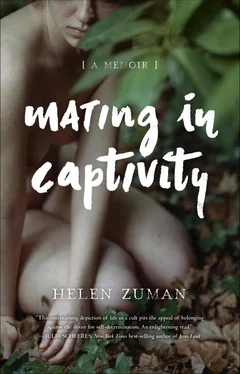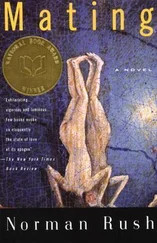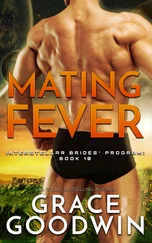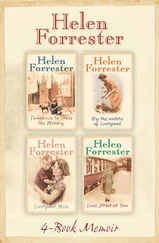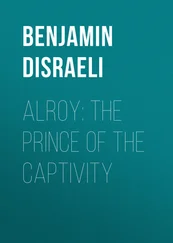I nodded. I knew the feeling.
“And then my dad sent me this book about cults. I was like, ‘Whatever—the Farm’s not a cult . People just say that ’cause they can’t take the truth.’ But I was curious, so I read it. And the way the guy describes cults—it gave me goose bumps. There was all this stuff that sounded so familiar.”
“Yeah? Like what?”
“You know how Arol used to build us up and knock us down? One week you’re her favorite; the next you’re shit, you shouldn’t even be a Zendik? Classic cult-leader crap. Keeps people off-balance.”
“Okay.” So Arol had wanted me anxious.
“That’s the basic way a cult works. It’s all about fear. You let people know they could be toast at any moment—and convince them they’ll die, or at best have shit lives, ‘out there’—and who’s gonna fight you? They’re all too scared.”
I smiled. A fifty-pound sack slid from my shoulders, a fifty-pound disk from my chest. A thrill of lightness filled me. I’d been hauling both for years.
But what about mating? Surely Arol had accrued true wisdom, in that regard. Hadn’t she and Swan formed the only lasting unions on the Farm?
“Did you notice,” Leah asked, “how Arol and Swan never had to talk about their sex lives? Never got accused of being ‘in a bubble’ with their boyfriends?”
“Yeah, sure.”
“Well, guess what? Maybe it’s not so hard to get close to someone when you know you won’t get slammed for it. How long do you think their relationships would have lasted if they’d taken the same shit we took?”
I pictured the Eye of Sauron table, in the dining hall in North Carolina; I imagined someone squinting at Arol and Prophet, then pouncing: “What’s up with those two? They sleep together every night. They never bring themselves up. Seems like they need a break. Or maybe they should get an apartment .” In the days after my breakthrough with Leah, I gloried in the gift of the world as it was. Yes, it brimmed with war, filth, glitz, lies—smothering warmth and beauty much of the time. But it was vast . And I was in it. Reminders of this—a dank gust from a subway tunnel, a block of dark chocolate savored while dancing down a crowded street, a goodbye kiss on my mother’s cheek—unleashed waves of gratitude for my miraculous release.
Yet doubt still stabbed me: Was I wrong? Do I have to go back? My new story needed reinforcement. On the afternoon of December 15, I picked up the book Leah had read— Combatting Cult Mind Control , by Steven Hassan—and finished it by midnight.
Hassan starts with his own story: As a college student seeking a purpose purer than money and wondering if he’d ever find true love, he joined a group pledging ascent to a higher plane—the Moonies. For two years, he rose through the ranks, excelling at recruiting and fundraising, and inching closer to the group’s leader, Sun Myung Moon. Seeing Moon as the Messiah, Hassan grew used to lying and manipulating in the name of world saving. He spent long days on the street, leading the Moonie version of Zendik selling trips (the Moonies hawked flowers, candles, candy, and other trifles for “donations”). On one trip—having forgone sleep to meet a sales quota—he dozed at the wheel and crashed the Moonie van into a tractor-trailer. He was rushed to the hospital with a broken leg.
It turned out to be a lucky break.
While he was immobile, his family brought in a team of deprogrammers—former Moonies who helped dissolve his cage from the inside while showing that those who’d left could be happy and whole. Later, grateful for the intervention but preferring a gentler approach, he developed exit counseling, which focused on coaxing the cult member to allow her inner voice to guide her out.
Reading Hassan’s story, I laid my own experience over its contours and found a rough fit: After college, I, too, had been fumbling for something to believe in and stumbling in my quest for love. Zendik had promised elite status and a bump in evolution. Taking Arol as my savior, I’d skewed my moral compass to match hers. I’d exhausted myself hawking merch for the cause. Finally, a painful break had forced me toward escape.
Reading on, I added strand after strand to the weave of my freedom:
In a cult, the leader holds total control, crushing protest.
In a cult, the follower yields self-rule and self-trust.
In a cult, the follower is always at fault.
In a cult, the follower gives everything, denying herself.
In a cult, the follower receives the leader’s words as sacred and uniquely pure, no matter how garbled they are.
In a cult, members take on the world’s weight, assuming responsibility for human salvation.
In a cult, departure means death—of body, soul, or both.
In a cult, the follower belongs only so long as she serves.
In a cult, love for the leader trumps every other love.
In a cult, the follower must shun outsiders, lest they lure her from the fold.
Cult. Cult. Cult. In those shaky early days, I relied on the word, and the weave it completed, to block the gate to Zendik—a gate I could not yet block on my own.
Years later, I still see “cult” as the noun that best fits the Farm; a group’s not a “commune” if one or two leaders control the money and own the land. But “cult” is a tricky term. Too often, it slices “us” from “them.”
What is a cult? Dictionaries give bloodless definitions, like this one from my 1976 Webster’s New Collegiate : “a religion regarded as unorthodox or spurious.”
The heart of the word beats elsewhere.
In 1978, in the Guyana jungle, over nine hundred members of the People’s Temple drank a deadly potion of cyanide-laced Flavor-Aid, on the last White Night. In 1993, in East Texas, eighty-two Branch Davidians died by fire and gunfire while resisting government intervention. In 1997, in Southern California, thirty-nine seekers of Heaven’s Gate took lethal doses of phenobarbital and fastened plastic bags over their heads, expecting to wake on a spaceship.
In 1988, my sixth-grade class watched a TV special marking the tenth anniversary of the massacre at Jonestown. Did the producers ask who the dead were? How they’d found the People’s Temple? What they’d hoped for when they’d joined? If so, the answers didn’t stick. Nothing stuck but the heaps of corpses in lurid Technicolor—scenes from a horror film, misfiled in real life. No wonder I sealed that story and others like it in a pit marked “evil,” “madness,” “them.”
In 2011, Julia Scheeres—herself a subject of religious violence—published A Thousand Lives: The Untold Story of Hope, Deception, and Survival at Jonestown . Drawing on sources such as a trove of recently declassified FBI documents, she showed that many entered the People’s Temple seeking what life outside had so far denied them: comfort, camaraderie, the chance to serve what seemed a worthy cause. She showed how some fought to survive. She returned a throng of “them” to the ring of human understanding.
So what is a cult, again?
An IV of meaning and belonging for those near starving? A plywood platform for players lacking parts on the larger stage? A pack of soft animals lured behind bars by the dream of the warmth of a tribe?
All groups fall along a continuum, from reverence to contempt for self-trust. I find no bright line dividing cult from culture—just stories jointly held, and questions invited or forced by crisis:
How well do our stories nourish us?
What pain do we cause in their service?
How might we revise them—for healing, for kinship, for joy?
Читать дальше
